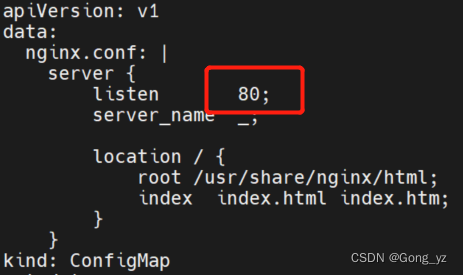
k8s--Kubernetes存储--Configmap配置管理
Configmap用于保存配置数据,以键值对形式存储。configMap 资源提供了向 Pod 注入配置数据的方法。旨在让镜像和配置文件解耦,以便实现镜像的可移植性和可复用性。典型的使用场景:1.填充环境变量的值2.设置容器内的命令行参数3.填充卷的配置文件
·
文章目录
一、环境的清理
##删除namespace
[root@server2 ingress]# kubectl get ns ##查看所有namespace,并删除
[root@server2 ingress]# kubectl delete pod --all -n demo --force ##先删除里面pod在删除ns会快一点
[root@server2 ingress]# kubectl delete ns demo
##删除pod
[root@server2 ingress]# kubectl delete pod --all -n test --force
[root@server2 ingress]# kubectl delete ns test
[root@server2 ingress]# kubectl delete pod nginx --force
[root@server2 ingress]# kubectl delete deployments.apps deployment
[root@server2 ingress]# kubectl delete pod demo --force
##删除服务
[root@server2 ingress]# kubectl get svc
[root@server2 ingress]# kubectl delete svc nginx-svc
##删除ingress服务
[root@server2 ingress]# kubectl delete ingress ingress-demo
## 删除网络策略
[root@server2 ingress]# kubectl delete networkpolicies. --all
二、Configmap配置管理
ConfigMap 是一种 API 对象,用来将非机密性的数据保存到键值对中
官方网址:https://v1-25.docs.kubernetes.io/zh-cn/docs/concepts/configuration/configmap/

Configmap用于保存配置数据,以键值对形式存储。
configMap 资源提供了向 Pod 注入配置数据的方法。
旨在让镜像和配置文件解耦,以便实现镜像的可移植性和可复用性。
典型的使用场景:
1.填充环境变量的值
2.设置容器内的命令行参数
3.填充卷的配置文件 ##使用较多
- 创建ConfigMap的方式有4种:
1.使用字面值创建
2.使用文件创建
3.使用目录创建
4.编写configmap的yaml文件创建
- 1.使用字面值创建
$ kubectl create configmap my-config --from-literal=key1=config1 --from-literal=key2=config2
- 2.使用文件创建
$ kubectl create configmap my-config-2 --from-file=/etc/resolv.conf
key的名称是文件名称,value的值是这个文件的内容
- 3.使用目录创建
$ kubectl create configmap my-config-3 --from-file=test
目录中的文件名为key,文件内容是value
- 4.编写configmap的yaml文件
$ vim cm1.yaml
apiVersion: v1
kind: ConfigMap
metadata:
name: cm1-config
data:
db_host: "172.25.0.250"
db_port: "3306"
$ kubectl create -f cm1.yaml
1. 使用字面值创建
[root@k8s2 configmap]# kubectl create configmap my-config --from-literal=key1=config1 --from-literal=key2=config2
[root@k8s2 configmap]# kubectl get cm
NAME DATA AGE
kube-root-ca.crt 1 5d23h
my-config 2 4s
[root@k8s2 configmap]# kubectl describe cm my-config
Name: my-config
Namespace: default
Labels: <none>
Annotations: <none>
Data
====
key2:
----
config2
key1:
----
config1
2.通过文件创建
[root@k8s2 configmap]# kubectl create configmap my-config-2 --from-file=/etc/resolv.conf

3.通过目录创建
[root@k8s2 configmap]# mkdir test
[root@k8s2 configmap]# cp /etc/passwd test/
[root@k8s2 configmap]# cp /etc/fstab test/
[root@k8s2 configmap]# ls test/
fstab passwd
[root@k8s2 configmap]# kubectl create configmap my-config-3 --from-file=test

4.通过yaml文件创建
[root@k8s2 configmap]# vim cm1.yaml
apiVersion: v1
kind: ConfigMap
metadata:
name: cm1-config
data:
db_host: "172.25.0.250"
db_port: "3306"
[root@k8s2 configmap]# kubectl apply -f cm1.yaml

三、如何使用configmap
如何使用configmap:
1.通过环境变量的方式直接传递给pod
2.通过在pod的命令行下运行的方式
3.作为volume的方式挂载到pod内 ##此方式最常用
1.使用configmap设置环境变量
[root@k8s2 configmap]# vim pod1.yaml
apiVersion: v1
kind: Pod
metadata:
name: pod1
spec:
containers:
- name: pod1
image: busybox
command: ["/bin/sh", "-c", "env"] ##env命令,显示当前系统环境变量
env: ##env此处用来定义相应的变量
- name: key1
valueFrom:
configMapKeyRef: ##映射的,相当于把cm( configMapKeyRef)中的值拿出来给key1
name: cm1-config
key: db_host
- name: key2
valueFrom:
configMapKeyRef:
name: cm1-config
key: db_port
restartPolicy: Never ##运行完退出
[root@k8s2 configmap]# kubectl apply -f pod1.yaml

[root@k8s2 configmap]# kubectl delete pod pod1
[root@k8s2 configmap]# vim pod2.yaml
apiVersion: v1
kind: Pod
metadata:
name: pod2
spec:
containers:
- name: pod2
image: busybox
command: ["/bin/sh", "-c", "env"]
envFrom:
- configMapRef:
name: cm1-config
restartPolicy: Never
[root@k8s2 configmap]# kubectl apply -f pod2.yaml

[root@k8s2 configmap]# kubectl delete pod pod2
2.使用conigmap设置命令行参数
[root@k8s2 configmap]# vim pod3.yaml
apiVersion: v1
kind: Pod
metadata:
name: pod3
spec:
containers:
- name: pod3
image: busybox
command: ["/bin/sh", "-c", "echo $(db_host) $(db_port)"] ##调用shell解析命令【"/bin/sh", "-c"】
envFrom:
- configMapRef:
name: cm1-config
restartPolicy: Never
[root@k8s2 configmap]# kubectl apply -f pod3.yaml
[root@k8s2 configmap]# kubectl logs pod3
172.25.0.250 3306
[root@k8s2 configmap]# kubectl delete pod pod3
3.通过数据卷使用configmap
[root@k8s2 configmap]# vim pod4.yaml
apiVersion: v1
kind: Pod
metadata:
name: pod4
spec:
containers:
- name: pod4
image: busybox
command: ["/bin/sh", "-c", "cat /config/db_host"]##挂载时:cm的key变成了文件名db_host,创建时:文件名变成key
volumeMounts: ##创建挂载点
- name: config-volume ##名字
mountPath: /config ##实际容器内的挂载点
volumes:
- name: config-volume ##当容器内要挂载卷,卷所映射的实际是什么,此处是cm1-config
configMap:
name: cm1-config
restartPolicy: Never
[root@k8s2 configmap]# kubectl apply -f pod4.yaml
[root@k8s2 configmap]# kubectl logs pod4
172.25.0.250
[root@k8s2 configmap]# kubectl delete pod pod4
4.configmap热更新
[root@k8s2 configmap]# vim nginx.conf
server {
listen 8000;
server_name _;
location / {
root /usr/share/nginx/html;
index index.html index.htm;
}
}
[root@k8s2 configmap]# kubectl create configmap nginxconf --from-file=nginx.conf
文件名变成key,文件内容变成值:

[root@k8s2 configmap]# vim my-nginx.yaml
apiVersion: apps/v1
kind: Deployment
metadata:
name: my-nginx
spec:
replicas: 1
selector:
matchLabels:
app: nginx
template:
metadata:
labels:
app: nginx
spec:
containers:
- name: nginx
image: nginx
volumeMounts:
- name: config-volume
mountPath: /etc/nginx/conf.d ##挂接点
volumes:
- name: config-volume ##映射的
configMap:
name: nginxconf
[root@k8s2 configmap]# kubectl apply -f my-nginx.yaml
[root@k8s2 configmap]# kubectl get pod -o wide
NAME READY STATUS RESTARTS AGE IP NODE NOMINATED NODE READINESS GATES
my-nginx-665dbc64f8-gps5w 1/1 Running 0 8s 10.244.219.13 k8s3 <none> <none>

[root@k8s2 configmap]# kubectl exec my-nginx-665dbc64f8-gps5w -- cat /etc/nginx/conf.d/nginx.conf
server {
listen 8000;
server_name _;
location / {
root /usr/share/nginx/html;
index index.html index.htm;
}
}
[root@k8s2 configmap]# curl 10.244.219.13:8000
<!DOCTYPE html>
<html>
<head>
<title>Welcome to nginx!</title>
<style>
html { color-scheme: light dark; }
body { width: 35em; margin: 0 auto;
font-family: Tahoma, Verdana, Arial, sans-serif; }
</style>
</head>
<body>
<h1>Welcome to nginx!</h1>
...
编辑cm,修改端口
[root@k8s2 configmap]# kubectl edit cm nginxconf

查看pod内的文件:端口也变为80
修改cm后,过上几秒配置信息会同步到容器,但是容器内运行的服务并不会加载生效,需要手动刷新
注意:服务的配置文件需要重载;不是服务的的文件不需要重载:如yaml文件、系统文件等等
方式一:(推荐)
[root@k8s2 configmap]# kubectl delete pod my-nginx-665dbc64f8-gps5w
方式二:(手动触发版本更新,会新建一个replicaset)
[root@k8s2 configmap]# kubectl patch deployments.apps my-nginx --patch '{"spec": {"template": {"metadata": {"annotations": {"version/config": "20230312"}}}}}'

更多推荐
 已为社区贡献16条内容
已为社区贡献16条内容






所有评论(0)